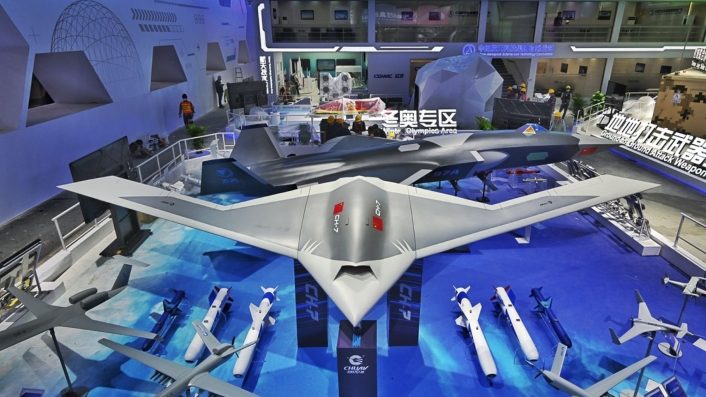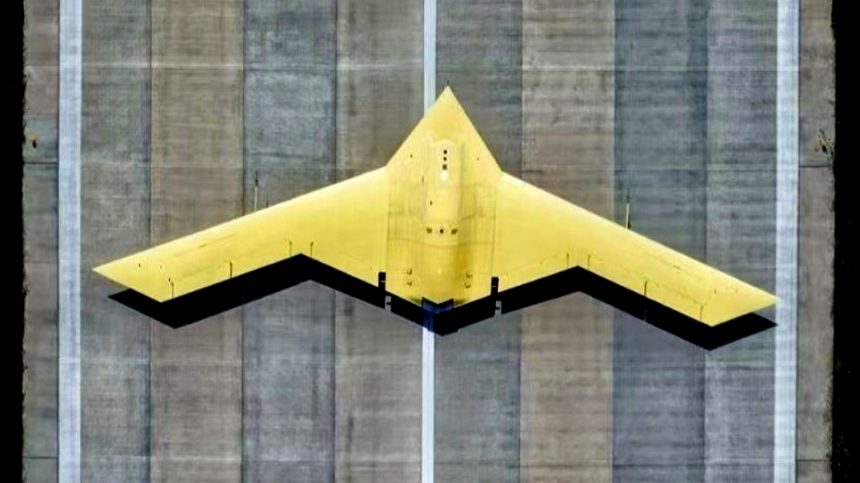The new flying wing CH-7 UCAV has a blended wing-body airframe with a high level of stealth and long-range capability, reportedly focused on continuous reconnaissance and monitoring in highly dangerous environments.
Images and videos have appeared online showing China’s massive CH-7 UCAV on a runway during what appears to be a taxi test. The aircraft was first unveiled in 2018 and later underwent several changes to the design, according to what Chinese reports described.
The final live model is shown in a yellow factory primer paint, although it is not clear if it is a prototype or a pre-serial production aircraft. The circling 360 degree video provides a view from all the angles of the tailless design.
In February 2024, Global Times reported that the CH-7 stealth UCAV (some reports have also called it the Rainbow 7, or Cai Hong-7) completed testing and the development phase is scheduled to conclude in 2024. Observers also expected the CH-7 to make an appearance at Zhuhai Airshow 2024 this week.
The first iteration of the drone was unveiled at the Zhuhai Airshow 2018, with a newer version displayed in the 2022 installment. Developed by CASC (China Aerospace Science and Technology Corporation), the CH-7 is powered by a single turbofan engine with a top-mounted air intake, and is meant for high-altitude deep penetration missions.
CH-7 Stealth Drone. pic.twitter.com/zlV26UxzHc
— International Defence Analysis (@Defence_IDA) November 8, 2024
The flying wing UCAV has a clearly visible blended wing-body airframe which “represents a high level of stealth and long range” capability “focused on round-the-clock reconnaissance and monitoring in highly dangerous environments,” according to Chinese reports. The CH-7 can “keep detecting hostile targets for a long time,” said Shi Wen, the chief engineer of the CH-series of drones, to Global Times at Airshow China in 2022.
The striking resemblance to one of first renderings of the still secret Northrop Grumman RQ-180 stealth UAS (Unmanned Aerial System), which made the front cover of Aviation Week in 2013, is also evident.
Just Fancy That https://t.co/uVDsK8K1OC pic.twitter.com/f9EWmP3y0x
— Bill Sweetman (@ValkStrategy) November 8, 2024
Changes from the previous displays
An exhibition scale model of the CH-7 in 2022 was shown with three different types of air-to-ground munitions, two of which appeared to have optical seekers. The UCAV has presumably undergone modification since then, as there are some discernible differences between the 2022 scale model and the new top-view picture of the live airframe on the runway.
The cranked-kite wing UCAV has a flat exhaust and what could be sensors on the intake nacelles, possibly meant as antennas to receive SATNAV (Satellite Navigation) signals, networked information-sharing and two-way data-linking transceivers.
The tests on the modified prototype “verified the aircraft’s outstanding performance and effectiveness of its airframe and structural design,” said Global Times. This implies that the UCAV has already flown before. The developers received “new designs to further enhance effectiveness in information-based combat in modern warfare.”

Global Times also provided some specifications, mentioning that the CH-7 has a wingspan of 26 meters, four meters longer than the original version, and a service ceiling of 15 kilometers, higher than the original version’s 10-13 kilometers.
With a maximum takeoff weight of 10 tons, the CH-7 can also carry large missiles or guide other weapons to strike high-value enemy targets. Other posts on X said it could have a maximum speed of 926 km/h and an endurance of 15 hours.
The absence of vertical stabilizers enhances the stealth features, especially from the side aspect, since there are no flat surfaces for the electromagnetic emissions to bounce off from. The aerodynamically smooth design suggests it has been optimized to maximize its performance in the airflow, with a strong flight control computer and software for stability augmentation.
The use of the CH-7 and the mystery drone
Overall, it could be said that the multiplicity of UAVs and UCAVs in the Chinese inventory, including the WZ-7, WZ-10, the GJ-11 Sharp Sword and the CH-9 UCAV, represents a reasoning about possessing both redundancy and attritability.
The unmanned systems performing reconnaissance, ELINT/EW and strike missions are highly vulnerable to Allied anti-air fire, yet they also reduce operational costs and human casualties, while also threatening to locate the enemy positions if engaged.
Actual CH-7pic.twitter.com/6IMDewi8mP
— Húrin (@Hurin92) November 8, 2024
What backs China’s unmanned doctrine is the industrial capability of having all supply chains within the country for aerospace components and electronics, unlike the U.S. that has embarked upon re-industrializing and domesticating their manufacturing only two years ago.
Since the time the UCAV first appeared in 2018, it has closely resembled the Northrop Grumman X-47B, although it sported canted wingtips instead of the triangular wingtip edges of the U.S. aircraft. At Airshow China 2022, the wing flaps were redesigned.
The CH-7, however, shows only some similarities to the mystery UCAV test model The Aviationist reported about in August, as the latest image shows that the canted wing sections are longer. The sweep angle and the overall proportions are also different, and the satellite images of the radar test facility show possibly canted vertical stabilizers towards the trailing edge.
What relationship the CH-7 has with this model is not clear, but it wouldn’t be far-fetched to presume the data generated from the radar reflective tests may have informed some part of the CH-7’s development.









